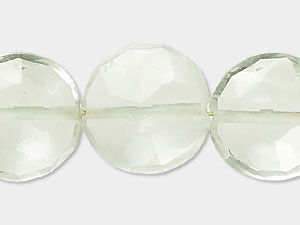Quartz, Green Meaning and Properties
Green Quartz History
Green quartz, also known as prasiolite, vermarine or lime citrine, is a macrocrystalline variety of the mineral quartz and is a rare stone in nature. This stone has been mistakenly referred to as "green amethyst" in the past, but the Federal Trade Commission of the United States has stated that is misleading, unfair and deceptive, and sellers who use this name could face legal action.
Natural green quartz is thought to be discovered in 1884 and is commonly known as "prasoilite," which is derived from two Greek words: prason, which means "leek," and lithos, which means "stone." Other names used for prasiolite are "praseolite" and "praziolite."
Green Quartz Metaphysical Properties
Green quartz is associated with the heart chakra and is thought to awaken love, empathy, compassion and increase connections with others. This stone helps people look on the bright side of things, turning negative energy into positive energy.
Green quartz can help bring peace and understanding in relationships and allows the wearer to approach stressful situations with patience and grace. Green quartz stimulates creativity and is believed to reduce anxiety, encourage financial success and support healthy recovery after illness or surgery.
Green Quartz Geological Properties
Green quartz is a macrocrystalline variety of the mineral quartz, the most abundant single mineral on earth. Most naturally occurring green quartz comes from a small mine in Brazil, with some minor deposits in Poland and Canada.
Because natural green quartz is so rare, it is more commonly a heat-treated amethyst. When heated, amethyst typically turns yellow or orange, but some will turn varying shades of green. Most green quartz on the market today results from a combination of heat treatment or ionizing radiation.
|
|
|
|
|
|
|
|
|
|
|
|
|
|
|
|
|
|
|
|
|
Proper Care of Green Quartz
Green quartz is fairly hard so it can be cleaned with an ultrasonic cleaner. Avoid heat with most forms of colorful quartzes to prevent hue shifts. Store green quartz out of direct sunlight to preserve its color.
Designing with Green Quartz
Because of its hardness, green quartz makes a good choice for use in any style of long-lasting jewelry, including rings, bracelets, earrings necklaces and more. Many designers like to complement green quartz with citrine and amethyst or contrast it with black onyx. Design with similar shades of crystal beads or pearls for a stunning statement. Accent this stone with sterling silver spacers for a stylish impact. Blend with filigree beads or marcasite components for vintage-inspired looks.
Shop for Green Quartz
**Please note that all metaphysical or healing properties listed are collected from various sources. This information is offered as a service and not meant to treat medical conditions. Fire Mountain Gems and Beads® does not guarantee the validity of any of these statements.
How did you like this resource? Your feedback helps us provide resources that matter to you most.
Copyright Permissions
All works of authorship (articles, videos, tutorials and other creative works) are from the Fire Mountain Gems and Beads® Collection, and permission to copy is granted for non-commercial educational purposes only. All other reproduction requires written permission. For more information, please email copyrightpermission@firemtn.com.

